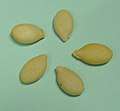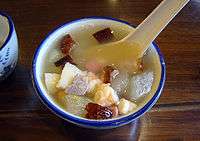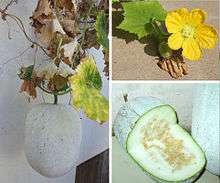Wax gourd
| Nutritional value per 100 g (3.5 oz) | |
|---|---|
| Energy | 54 kJ (13 kcal) |
|
3 g | |
| Dietary fiber | 2.9 g |
|
0.2 g | |
|
0.4 g | |
| Vitamins | Quantity %DV† |
| Thiamine (B1) |
3% 0.04 mg |
| Riboflavin (B2) |
9% 0.11 mg |
| Niacin (B3) |
3% 0.4 mg |
| Pantothenic acid (B5) |
3% 0.133 mg |
| Vitamin B6 |
3% 0.035 mg |
| Vitamin C |
16% 13 mg |
| Minerals | Quantity %DV† |
| Calcium |
2% 19 mg |
| Iron |
3% 0.4 mg |
| Magnesium |
3% 10 mg |
| Manganese |
3% 0.058 mg |
| Phosphorus |
3% 19 mg |
| Sodium |
7% 111 mg |
| Zinc |
6% 0.61 mg |
|
| |
| |
|
†Percentages are roughly approximated using US recommendations for adults. Source: USDA Nutrient Database | |
Benincasa hispida, the wax gourd,[2][3] also called ash gourd,[4] white gourd, winter gourd, tallow gourd, ash pumpkin, and winter melon[4] and “Chinese preserving melon”[4] is a vine grown for its very large fruit, eaten as a vegetable when mature.
It is the only member of the genus Benincasa. The fruit is fuzzy when young. The immature melon has thick white flesh that is sweet when eaten. By maturity, the fruit loses its hairs and develops a waxy coating, giving rise to the name wax gourd, and providing a long shelf life. The melon may grow as large as 80 cm in length. It has yellow flowers and broad leaves.[5] The taste is rather bland.[6]
It is native to South Asia and Southeast Asia. The wax gourd is widely grown throughout Asia,[7] including Java and Japan[8] where it is thought to have originated.[5]
Etymology
The name “winter melon” that is sometimes given to this plant is based on the Chinese name 冬瓜 or dōngguā, however, the character 瓜 or guā can also mean “gourd” or “squash”.[9] It is likely that the name “melon” is given because this gourd is sometimes candied or made into a sweet tea; see the Uses section below.
Cultivation
It is grown in well drained loam and sandy soils, in warm mild climates, but will not tolerate frosts. The crops are grown in riverbeds or furrows, and needs constant irrigation during the growing season.[5]
Uses
The wax gourd requires very warm weather to grow but can be stored for many months much like winter squash. Ash gourds of the Indian subcontinent have a white coating with rough texture (hence the name ash gourd, literally, in some vernaculars). South East Asian varieties have a smooth waxy texture. It is one of the few vegetables available during winter in areas of deciduous vegetation, hence its Chinese name literally means 'winter gourd'. The Wax Gourd can typically be stored for 12 months. In India, the wax gourd is recognized for its medicinal properties in the Ayurvedic system of medicine.[8] It is also has significance in spiritual traditions of India and Yoga, where it is identified as a great source of Prana.[10]
In Vietnamese cuisine, it is called bí đao, which is usually used to make soup or stew.[11] When cooked with pork short ribs, the resulting soup is traditionally thought to help produce more milk for breastfeeding mothers.
In Chinese cuisine the gourds are used in stir fry or usually combined with pork or pork/beef bones to make winter gourd soup, often served in the scooped out gourd, carved by scraping off the waxy coating. It is also chopped and candied[12] as wintermelon candy (táng dōng guā) to be commonly eaten at New Year festivals, or as filling for Sweetheart cake (lǎopó bǐng). It has also been used as the base filling in Chinese and Taiwanese mooncakes for the Moon Festival.
In the Philippines it is candied (referred to plainly as kundol) and is used as a pastry filling for bakpia (hopia in the Philippines). It is also an ingredient in some savory soups (sabaw) and stir-fries (guisado).
In Indian cuisine this gourd is traditionally used to prepare a wide variety of dishes. In northern India it is used to prepare a candy called Petha. In South Indian cuisine, it is traditionally used to make a variety of curries, including a stew made with a yogurt base.[13] The juice of raw ash gourd is used by the Mizo community of North-East India as a natural remedy to treat mild to severe dysentery.
In Nepal, where it is called Kubhindo, it is cooked as a vegetable when young, but the ripe gourds are usually popular in making preserves or crystallized candied sweet known as "murabba" or "petha".[14]
Occasionally, it is used to produce a fruit drink with a very distinctive taste. It is usually sweetened with caramelized sugar. In Southeast Asia, the drink is widely marketed as wax gourd tea or wax gourd punch.
The shoots, tendrils, and leaves of the plant may also be eaten as greens.[15]
Gallery
 Nearly mature wax gourd
Nearly mature wax gourd Wax gourd
Wax gourd Seeds
Seeds Wax gourd on the vine
Wax gourd on the vine Chinese winter melon soup
Chinese winter melon soup
References
- ↑ "The Plant List: A Working List of All Plant Species". Retrieved April 10, 2014.
- ↑ Wax Gourd, Editors of 'Encyclopædia Britannica'. Accessed at on 19.11.2012.
- ↑ Useful Tropical Plants, 'Benincasa hispida'. Accessed on 19.11.2017.
- 1 2 3 , "Multilingual Multiscript Plant Name Database". Retrieved 10 April 2014.
- 1 2 3 D. K. Salunkhe and S. S. Kadam (Editors)Handbook of Vegetable Science and Technology: Production, Composition, Storage and Processing, p. 290, at Google Books
- ↑ Specialty Produce, 'Winter Melon'. Accessed on 19.11.2017.
- ↑ "Benincasa hispida - Plant Finder". www.missouribotanicalgarden.org.
- 1 2 T. R. Gopalakrishnan Vegetable Crops, p. 138, at Google Books
- ↑ MDBG Word Dictionary
- ↑ "Ash Gourd (Winter Melon), the "Cool" Vegetable: Benefits & Recipes - The Isha Blog". The Isha Blog. 2017-05-04. Retrieved 2018-02-16.
- ↑ "Winter Melon Soup - Canh Bí Đao". youtube.com. 30 August 2014. Retrieved 1 June 2017.
- ↑ "How to make Candied Winter Melon aka Tung Kua(冬瓜糖)". 2009. Retrieved 18 December 2011.
- ↑ "Majjige huli with winter melon".
- ↑ Taste of Nepal, 'Kubhindo - Ash Gourd (कुभिन्डो)'. Accessed 19.11.2017.
- ↑ "~Winter Squash Leaves in Salted Coconut Milk". praneesthaikitchen.com. 9 August 2011. Retrieved 2 June 2017.
External links


